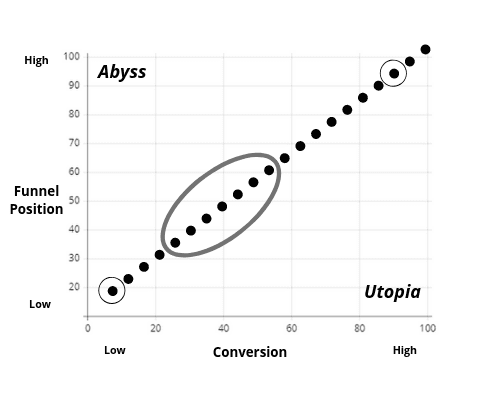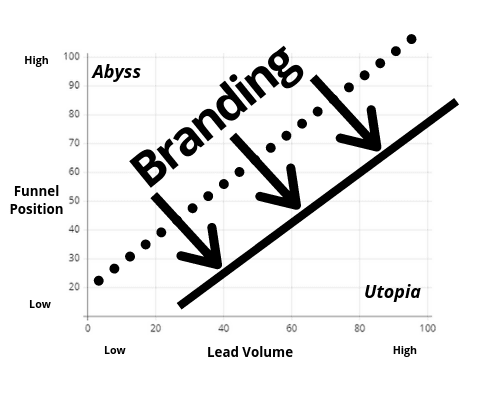How Branding Unlocks High-Quality Lead Gen
Many businesses sacrifice branding efforts because quarterly revenue targets need more attention. Typically an ongoing battle between sales and marketing is the root cause and moves between the need for more leads or the demand for higher quality leads. Both teams usually point the finger at the other and neither is ever really satisfied with results from the other side. Dialing in the right balance of lead volume and lead quality continues to be elusive for Marketing Directors.
Here’s one way to look at how the importance of branding and how it is the key to unlocking long-term company growth.
Marketing Abyss or Marketing Utopia
Marketers have two lead-gen extremes – delivering high volume low-quality leads or delivering low volume high-quality leads. High-volume low-quality leads are easy to get and usually have meager sales conversion rates. Consistently delivering high volume high-quality and high-converting leads to a sales team is a utopian state rarely achieved for long. Many companies end up somewhere in the middle. Sales and marketing accept living with the average lead volume, average quality, and average lead conversion.
With lead generation, particularly from digital channels, there are three types of leads: Good, Fast, and Cheap.
Good leads are low in the funnel, aware of your brand, have a strong need, and are likely to convert with relatively little nurturing. The problem is that there aren’t enough of them.
Fast leads arrive in large numbers in short time frames. Some lead sources have large amounts of traffic and can produce lots of potential customers very quickly. Other sources have smaller audiences, less-engaged audiences, or audiences that are simply in a different frame of mind, which leads to fewer leads filling your pipeline.
Cheap leads are those that come in at a low cost per lead.
The relationship between the leads is worth a deeper dive. If there aren’t enough good leads available, then it’s nearly impossible to get fast leads without sacrificing the overall quality. At the same time, if you want to maintain high quality without sacrificing volume, you must be prepared to increase your cost per lead.
For lead generation, in particular, it is helpful to cut out the cost dimension. With that in mind, let’s assume the budget for a given campaign is static, leaving the relationship between quality and volume looking like Chart 1. The dotted line represents the relationship between quality and volume, where a higher volume requires a reduction in quality.
Note: quality is represented by Funnel Position, which is effectively an inverse of quality, allowing simpler analysis.

In the top left of the chart, there is a world where you get very few leads, and they are of very low quality. This is the abyss, lead hell if you will. No one wants to be there. If you are there, you need to rethink your overall strategy and target audience. If your spending is well-optimized, you may need to rethink the viability of your overall business plan.
In the bottom right of the chart is Utopia, a magical place where you get the highest quality leads in a quantity that you can barely handle. Sadly, Utopia isn’t real. You cannot reasonably expect to live in a business world where more customers than you can reasonably service demand your product.
Not All Marketing Channels Produce The Same Results
With an understanding of the chart above, we can now start to discuss the dynamic of the well-optimized line as it relates to specific channels and tactics. This will let you understand where your marketing efforts fall along this line and what can be done to move away from the abyss and closer to Utopia.
It shouldn’t come as any surprise that different tactics and channels deliver different results. Let’s address two common digital channels and two tactics in those channels to draw out the point.
Facebook can be a great marketing channel as long as you understand where Facebook is strong and where it is weak. Facebook can generate both awareness and leads, which gives it a unique position in the marketing mix. From lead generation, Facebook is also higher in the funnel than other sources. Unlike paid search, Facebook users are often just browsing through content and not actively searching for a product or service.
When using Facebook as a lead generation source, there are also two distinct options for where and how to capture the leads: lead ads and website conversions. Lead ads are quick and easy for a user to complete, but they force the user to submit the lead without giving them the opportunity to search for more information prior to taking action. Website conversions, by contrast, provide the user with a chance to interact with the brand’s website, read more details and get more familiar with your products and services, but it opens the door for potential customers to abandon the process before taking action. Lead ads are typically more plentiful but higher in the funnel. Meanwhile, website conversion ads are fewer and farther between but have a higher likelihood of converting from lead to sale.
In contrast, leads from paid search campaigns are typically lower in the conversion funnel because the interaction begins with the user taking specific action to inquire about a product or service. In paid search, there are also two different types of leads: branded and non-branded. When someone searches for your brand by name, they are much more likely to convert, but they’re often aren’t enough of them. Meanwhile, non-branded (category-based) keywords are searched far more frequently. In most cases, the user is not yet committed to a specific brand. Non-branded leads have a lower lead-to-sale conversion. This is represented in Chart 2 below.
We have laid out the basic assumptions and determined where a few different lead sources belong on this chart. There is an interesting question to be answered: where does branding belong?
Some suggest branding belongs on the curve outlined above, in a position beyond Facebook lead ads. Branding has a large reach, can generate a high number of leads, and leads are high in the funnel. The average person would likely not be in-market for the products or services offered.
Others claim branding belongs in the abyss because the conversion rate is lower than more lead generation-focused channels. Those people who do become a lead after seeing a piece of traditional branding would likely be very far from making an actual purchase.
How Branding Affects Lead Generation
We looked into our data, and we found advertisers running traditional campaigns without any digital lead generation, and advertisers running digital lead gen both with and without traditional branding. A few cases had advertisers running both who chose to pause branding efforts for only a month or two, allowing us to compare month-over-month and year-over-year data.
The results of this analysis are in the chart below. Traditional branding campaigns do not have a specific spot on the chart. Instead, they exert pressure on the curve, pushing digital lead generation campaigns towards Utopia.

Chart 3 shows advertisers the importance of combining traditional branding with digital advertising.
Let’s take a specific example of paid search. A well-branded product or service will likely see a larger number of branded searches and more leads, moving the curve to the right. At the same time, traffic from non-branded terms will likely have higher conversion rates since those users are more likely familiar with, and possibly have an affinity for the brand.
A stronger brand reputation will likely increase click-through rates for non-branded terms since the user more likely recognizes the brand – even when searching in a brand-agnostic way. Google’s ad quality score is likely to increase lowering cost-per-click. Similar logic applies to social media campaigns.
Conclusion: Combine Branding and Lead Generation for Best Results
When discussing lead generation, understanding the relationship between lead quantity and lead quality is important. Using the charts provided, discussions around lead volume and lead quality help shape budget allocations and assist in setting realistic expectations. You now have a framework for where and when branding fits into your marketing mix. Plus, you know how branding impacts your lead generation. Especially, if lead generation campaigns are struggling to deliver effective results, the right answer might be branding, rather than optimization.
Click for more on how Colling Media can help combine branding with your lead generation efforts.
Chart assumptions (1) marketing spend remains the same (2) High quantity leads cost less than high-quality leads.
